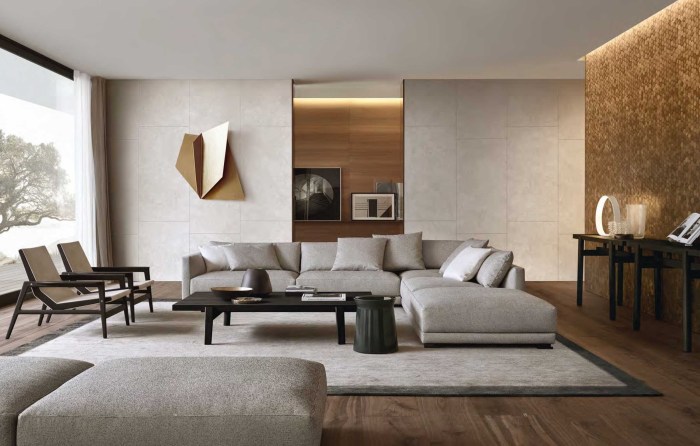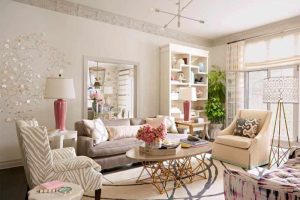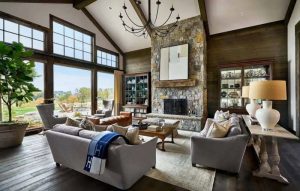
Modern interior design, with its clean lines and functional approach, has become a dominant force in contemporary homes. Beyond its aesthetic appeal, modern design embraces functionality and practicality, creating spaces that are both visually stunning and conducive to comfortable living. This style thrives on the interplay of light, space, and form, incorporating furniture that not only serves a purpose but also enhances the overall ambiance of the room.
From the minimalist elegance of Scandinavian design to the bold statement of industrial aesthetics, there’s a modern furniture style to complement every taste and preference. This exploration delves into the key characteristics, historical influences, and defining features of popular furniture styles within the modern interior design landscape.
Defining Modern Interior Design
Modern interior design is a style that emerged in the early 20th century, breaking away from the ornate and traditional styles of the past. It embraces simplicity, functionality, and clean lines, reflecting the changing social and technological landscape of the time. Modern design emphasizes a departure from the elaborate details and historical references of traditional styles. It prioritizes functionality and efficiency, using materials and forms in a straightforward and uncluttered manner.
Historical Context and Influences
Modern interior design was heavily influenced by the artistic and social movements of the early 20th century, such as the Bauhaus school in Germany and the Art Deco movement in France. The Bauhaus school, founded in 1919, emphasized functionality and simplicity in design, using geometric shapes and industrial materials. Art Deco, known for its geometric patterns, luxurious materials, and bold colors, also played a significant role in shaping the aesthetics of modern interior design.
Renowned Modern Interior Designers
Modern interior design has been shaped by the contributions of many talented designers. Some of the most influential figures include:
- Ludwig Mies van der Rohe: Known for his minimalist designs and use of steel and glass, Mies van der Rohe’s work exemplifies the principles of modernism. His iconic Barcelona Chair and the Barcelona Pavilion are testaments to his influential approach.
- Le Corbusier: A Swiss architect and designer, Le Corbusier was a pioneer of modern architecture and interior design. His “Five Points of Architecture” Artikeld principles of functionality, open floor plans, and the use of new materials.
- Frank Lloyd Wright: An American architect and designer, Frank Lloyd Wright is renowned for his organic and functional designs. He emphasized the integration of architecture with nature, using natural materials and open floor plans to create a sense of harmony.
Popular Furniture Styles in Modern Interior Design
Modern interior design is characterized by clean lines, minimalist aesthetics, and a focus on functionality. This approach extends to the furniture, which plays a crucial role in shaping the overall look and feel of a modern space. Let’s delve into some of the most popular furniture styles that contribute to the modern interior design aesthetic.
Mid-Century Modern
Mid-century modern furniture emerged in the mid-20th century and continues to be a popular choice in modern interiors. This style is known for its organic forms, use of natural materials, and focus on comfort and functionality.
- Materials: Mid-century modern furniture often incorporates materials like wood, leather, and metal, which are durable and aesthetically pleasing. These materials add warmth and texture to the space.
- Forms: The forms of mid-century modern furniture are often characterized by flowing lines, geometric shapes, and a focus on functionality. The iconic Eames Lounge Chair is a perfect example of this style, with its distinctive form and use of leather and molded plywood.
- Functionalities: Mid-century modern furniture is designed to be both comfortable and functional. The furniture is often modular, allowing for customization and flexibility in a space.
Mid-century modern furniture seamlessly blends with the modern aesthetic, creating a timeless and sophisticated look.
Scandinavian
Scandinavian furniture is characterized by its simplicity, functionality, and focus on natural materials. This style emphasizes clean lines, light colors, and a sense of openness.
- Materials: Scandinavian furniture often uses natural materials like wood, leather, and wool. These materials are sustainable and add warmth and texture to the space.
- Forms: Scandinavian furniture is known for its simple, geometric forms and minimal ornamentation. The furniture is often designed with a focus on functionality and comfort.
- Functionalities: Scandinavian furniture is designed to be both practical and aesthetically pleasing. The furniture is often modular and multi-functional, making it suitable for small spaces.
Scandinavian furniture adds a sense of calm and serenity to modern interiors, creating a welcoming and inviting atmosphere.
Industrial
Industrial furniture draws inspiration from the industrial revolution, characterized by its use of raw materials, exposed elements, and a rugged aesthetic.
- Materials: Industrial furniture often uses materials like metal, wood, and concrete. These materials are durable and add a sense of authenticity to the space.
- Forms: Industrial furniture is characterized by its simple, utilitarian forms and exposed elements. The furniture is often designed with a focus on functionality and durability.
- Functionalities: Industrial furniture is designed to be both practical and stylish. The furniture is often modular and can be easily adapted to different spaces.
Industrial furniture adds a unique and edgy touch to modern interiors, creating a sense of urban sophistication.
Contemporary
Contemporary furniture is a broad term that encompasses a variety of styles that are currently popular. This style is characterized by its focus on innovation, experimentation, and the use of new materials and technologies.
- Materials: Contemporary furniture often incorporates a wide range of materials, including metal, glass, acrylic, and textiles. These materials add a sense of modernity and sophistication to the space.
- Forms: Contemporary furniture is known for its innovative and experimental forms. The furniture is often designed with a focus on functionality and comfort.
- Functionalities: Contemporary furniture is designed to be both practical and stylish. The furniture is often modular and can be easily adapted to different spaces.
Contemporary furniture adds a sense of modernity and sophistication to modern interiors, reflecting the latest trends in design.
Key Elements of Modern Furniture

Modern furniture design is characterized by its clean lines, minimalist aesthetics, and emphasis on functionality. These elements create a sense of spaciousness and order, reflecting the values of modernism.
Use of Natural Materials
The use of natural materials in modern furniture design is a key element that contributes to its timeless appeal and sustainability. Natural materials, such as wood, leather, and stone, bring a sense of warmth, texture, and authenticity to modern interiors.
- Wood: Wood is a versatile and durable material that is commonly used in modern furniture. Its natural grain patterns add visual interest and warmth to any space. Different wood species, such as oak, walnut, and maple, offer a range of colors and textures.
- Leather: Leather is a luxurious and durable material that is often used in modern furniture, particularly for upholstery. Its rich texture and patina add a touch of sophistication and elegance to any room.
- Stone: Stone is a durable and elegant material that is often used in modern furniture for tabletops, bases, and accents. Its natural beauty and weight add a sense of solidity and permanence to any space.
Clean Lines, Geometric Shapes, and Minimalist Aesthetics
Modern furniture is known for its clean lines, geometric shapes, and minimalist aesthetics. These elements create a sense of order and simplicity, reflecting the values of modernism.
- Clean Lines: Modern furniture avoids unnecessary ornamentation and focuses on simple, clean lines. This creates a sense of spaciousness and visual clarity.
- Geometric Shapes: Modern furniture often incorporates geometric shapes, such as squares, rectangles, and circles. These shapes create a sense of order and structure, while also adding visual interest.
- Minimalist Aesthetics: Modern furniture embraces minimalism, emphasizing functionality and simplicity over excessive decoration. This approach creates a sense of calm and serenity, allowing the furniture to blend seamlessly into the surrounding space.
Functionality and Practicality
Modern furniture design places a strong emphasis on functionality and practicality. This means that every piece of furniture should serve a purpose and be designed for ease of use.
- Multi-Functionality: Modern furniture often incorporates multi-functional elements, such as storage compartments, pull-out drawers, and convertible pieces. This maximizes space efficiency and creates a sense of organization.
- Ease of Use: Modern furniture is designed for ease of use, with intuitive features and ergonomic design. This ensures that the furniture is comfortable and practical for everyday use.
- Durability: Modern furniture is typically made from durable materials that are designed to withstand wear and tear. This ensures that the furniture will last for many years to come.
Popular Furniture Styles in Different Modern Interior Design Subgenres
Modern interior design is a broad category encompassing diverse subgenres, each with its unique aesthetic and furniture styles. Understanding these subgenres and their furniture styles allows for a more nuanced appreciation of modern design and facilitates the creation of a cohesive and personalized interior space.
Scandinavian Furniture Style
Scandinavian design, often characterized by its simplicity, functionality, and natural materials, has a distinct furniture style. This style prioritizes clean lines, minimalist forms, and a focus on natural materials like wood, leather, and wool.
- Minimalist Designs: Scandinavian furniture typically features clean lines, simple shapes, and a lack of unnecessary embellishments. The focus is on functionality and practicality, with each piece serving a clear purpose.
- Natural Materials: Wood is a staple material in Scandinavian furniture, often used in its natural form to highlight its beauty and texture. Other common materials include leather, wool, and linen, all known for their durability and natural appeal.
- Light and Airy: Scandinavian furniture often features light colors, such as white, beige, and gray, which contribute to a sense of spaciousness and airiness. This is further enhanced by the use of natural light and the incorporation of large windows.
Examples of Scandinavian furniture pieces include:
- The Eames Lounge Chair: This iconic chair, designed by Charles and Ray Eames, exemplifies the simplicity and elegance of Scandinavian design. Its curved plywood shell, leather upholstery, and minimalist base make it a timeless classic.
- The Wishbone Chair: Designed by Hans J. Wegner, this chair is known for its distinctive Y-shaped backrest and its use of natural wood. Its simple yet elegant design makes it a versatile piece suitable for both dining and living spaces.
- The String Shelving System: This modular shelving system, designed by Nisse Strinning, allows for customizable storage solutions. Its simple design and use of natural wood make it a functional and aesthetically pleasing addition to any room.
Home Improvement

A home improvement project that embraces modern furniture styles can transform a space into a stylish and functional haven. By incorporating carefully selected pieces, you can create a cohesive and contemporary design that reflects your personal taste.
Modern Furniture Styles in a Home Improvement Project
Let’s imagine a living room renovation where the goal is to create a sophisticated and welcoming space. The chosen furniture styles are minimalist, sleek, and characterized by clean lines and neutral color palettes.
- Sofa: A modular sofa with a low profile and a soft, inviting fabric. This sofa is made of durable materials like solid wood and high-density foam. The modular design allows for customization, enabling the homeowner to create a configuration that best suits the space. This sofa would be 8 feet long and 3 feet deep, offering ample seating for guests.
- Coffee Table: A rectangular coffee table with a simple design, crafted from natural materials like walnut or oak. The table features a minimalist base and a smooth, polished top, creating a clean and elegant look. The dimensions would be 4 feet long, 2 feet wide, and 18 inches high, providing ample space for drinks, books, and decorative items.
- Armchairs: Two sleek armchairs with a comfortable yet structured design. The armchairs are upholstered in a neutral fabric like linen or velvet, adding a touch of sophistication to the space. These armchairs would have a compact size, measuring 2.5 feet wide, 2 feet deep, and 3 feet high, ideal for creating a cozy reading nook or a welcoming conversation area.
- Rug: A geometric rug with a subtle pattern and neutral colors like gray, beige, or white. The rug is made from natural materials like wool or jute, adding a touch of warmth and texture to the space. The rug would be 8 feet long and 6 feet wide, defining the seating area and providing a grounding element to the room.
The chosen furniture styles complement the overall design aesthetic by creating a sense of openness, airiness, and sophistication. The clean lines and neutral colors of the furniture create a visually calming and inviting atmosphere. The use of natural materials adds warmth and texture, while the modular design of the sofa allows for flexibility and customization.
Modern furniture styles are more than just trends; they represent a shift in how we live and interact with our surroundings. By embracing functionality, simplicity, and timeless design, modern furniture pieces elevate the aesthetic and functionality of any space. Whether you’re seeking to create a serene Scandinavian haven, a sleek Mid-Century Modern retreat, or an industrial-inspired loft, understanding the nuances of these styles can guide you in creating a home that reflects your personal style and embodies the spirit of modern living.
Question Bank
What are the key differences between Scandinavian and Mid-Century Modern furniture?
Scandinavian furniture emphasizes simplicity, natural materials, and light colors, while Mid-Century Modern often incorporates bolder shapes, geometric patterns, and a wider range of materials, including plastics and metals.
How can I incorporate modern furniture into a traditional space?
Start by introducing a few modern pieces, like a sleek sofa or a geometric coffee table. Choose pieces that complement the existing style and create a balanced aesthetic.
What are some popular materials used in modern furniture?
Modern furniture often features natural materials like wood, leather, and stone, but also incorporates metal, glass, and plastic for a contemporary look.







